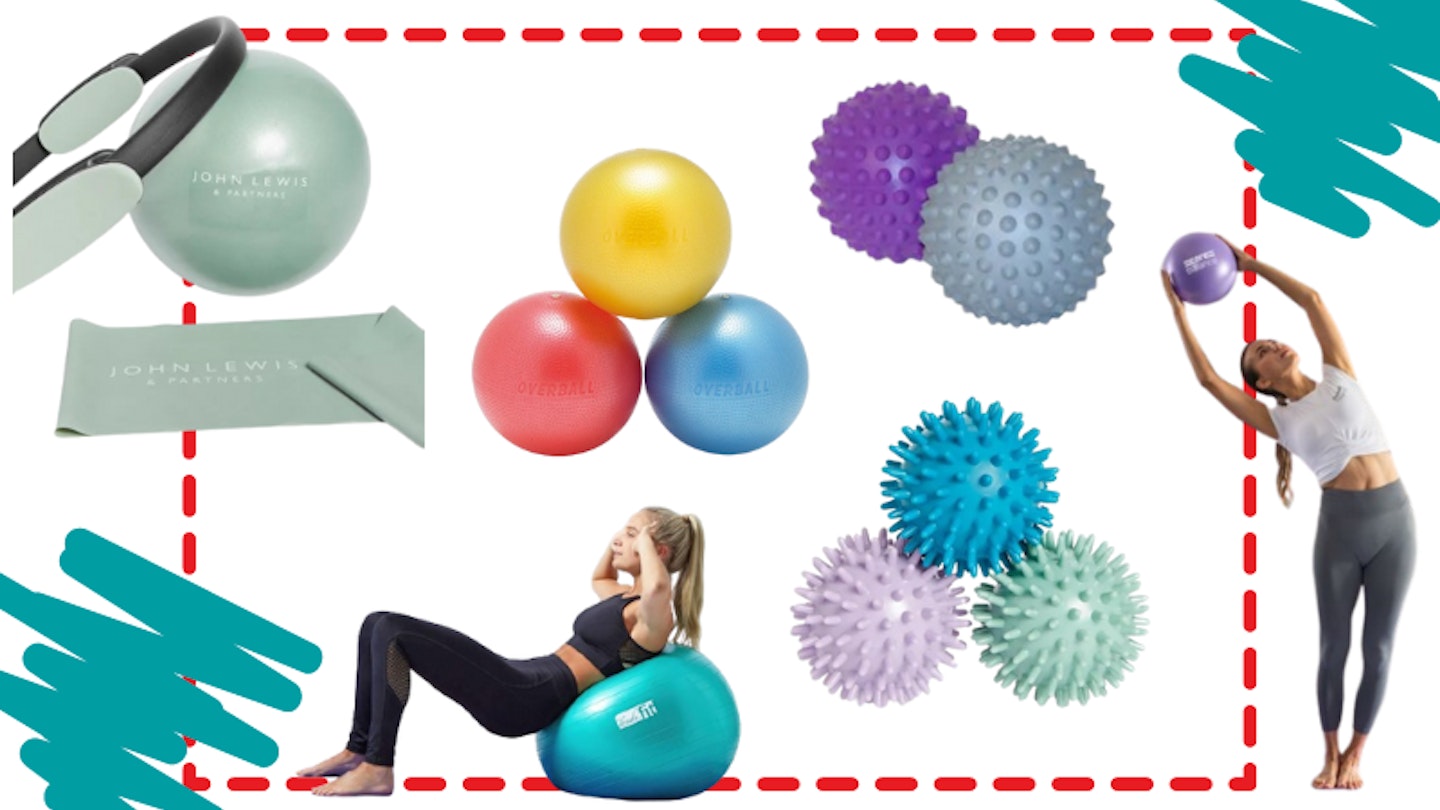If you’re looking to kick your workout routine up a notch, you may be considering a Pilates ball. You may be unsure where to start, so here’s a how-to on everything you’ll need to know before trying them out. If you're new to pilates in general, we also have a beginner's Pilates guide which we recommend starting with. Before you buy your own Pilates ball, it’s recommended that you try them out in your local gym to see which one is best for you. There are plenty of Pilates accessories out there, but Pilates balls are a tried and tested favourite.
Alternatively, if you've noticed that you've been experiencing back or neck pain, a pilates ball could be a great way to ease the tension. A study published in the National Library of Medicine examined the benefits of even just swapping your office chair with a pilates ball. Doctor Larry G Merritt wrote that in many case studies, the exercise ball "had helped reduce the recurrence of back and neck pain, and also seemed to reduce the severity of the episodes of pain as well."
What size Pilates ball do I need?
There are a few different sizes of Pilates balls, and each has a different use.
The largest is the stability ball, also known as a fitness, gym, or Swiss ball. These are made of soft elastic and filled with air and are perfect for a reverse abs exercise, hamstring curls, and hip thrusts. These tend to come in 3 main sizes; 55cm, 65cm or 75cm, to correspond with the user’s height difference.
 Movedancewear.com
Movedancewear.comMove and Dancewear exercise ball
The Tendu exercise ball is really useful for yoga, pilates or core toning exercises. It is ideal for anyone looking to improve core strength and work on stability, or even just those looking to try Pilates out for the first time. It has a diameter of 65cm and is perfect for users of various heights and fitness levels, so even if you're just a beginner this is a really handy pilates tool.
Pros
- The pump is included, so there's no hidden costs.
- Very affordable compared to other exercise balls on the market.
Cons
- Some users found material used for the ball's exterior to be too slippery, but using a yoga mat should help this issue.
2.
Pilates set
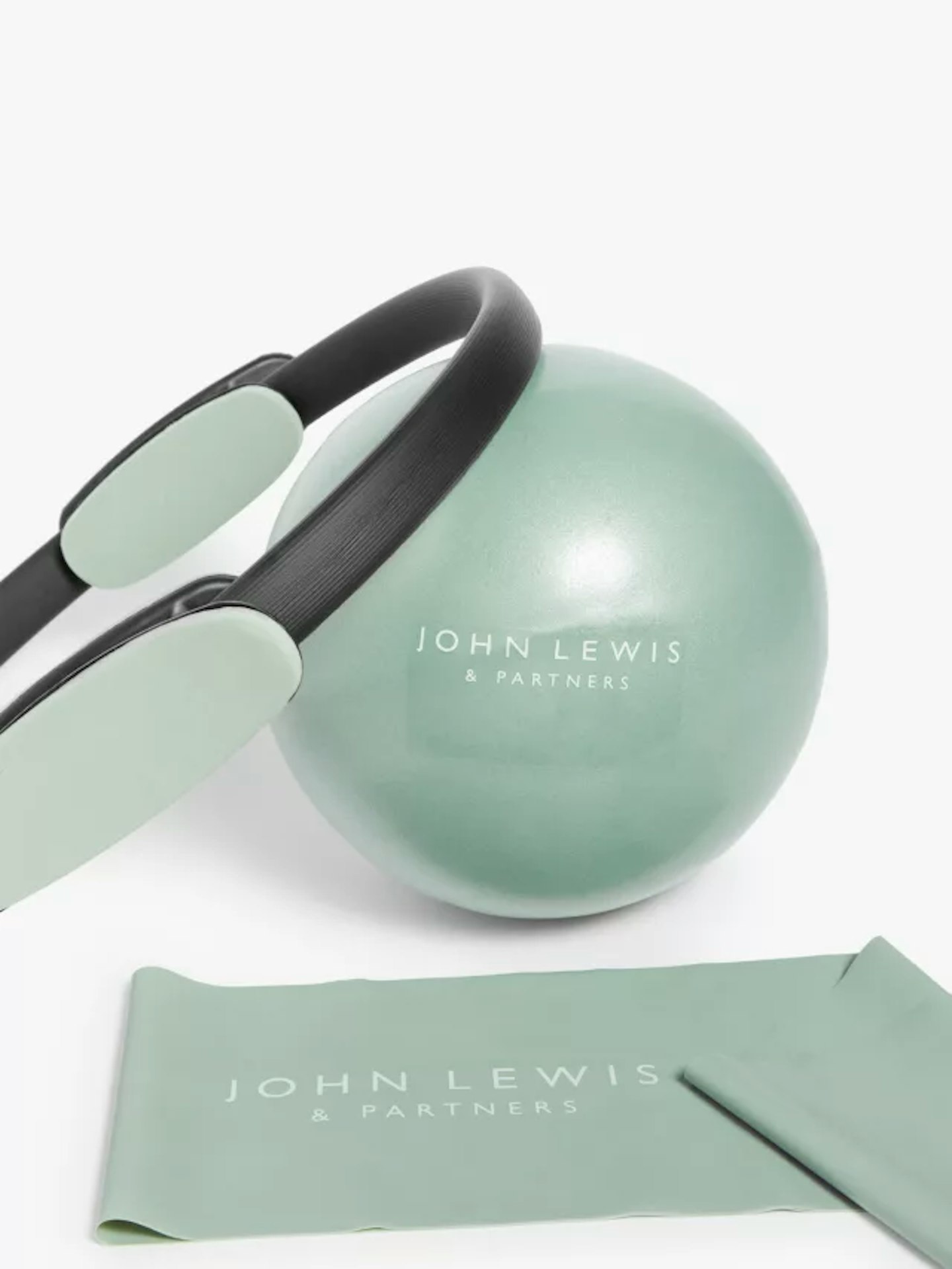
John Lewis Pilates set
This John Lewis set is perfect if you're new to Pilates and are unsure where to start. Pilates can be a little daunting, so a set like this is perfect if you just want to give everything a try before you commit. This set includes a resistance band, balance ball and a pilates ring, making it the perfect starter kit. This kit is great for warming up, stretching muscles and preventing injury.
Pros
- Convenient and portable, making it perfect for travelling to workouts.
- Great value considering you get all of your tools in one kit.
Cons
- The mat is a little thinner than others on the market at that price point.
- There's no guide or instructions included, so you'll need to find tips and examples of exercises elsewhere.
An over ball is the standard Pilates ball and is about the size of a netball. These are soft, filled with air, and are particularly useful for strength work.
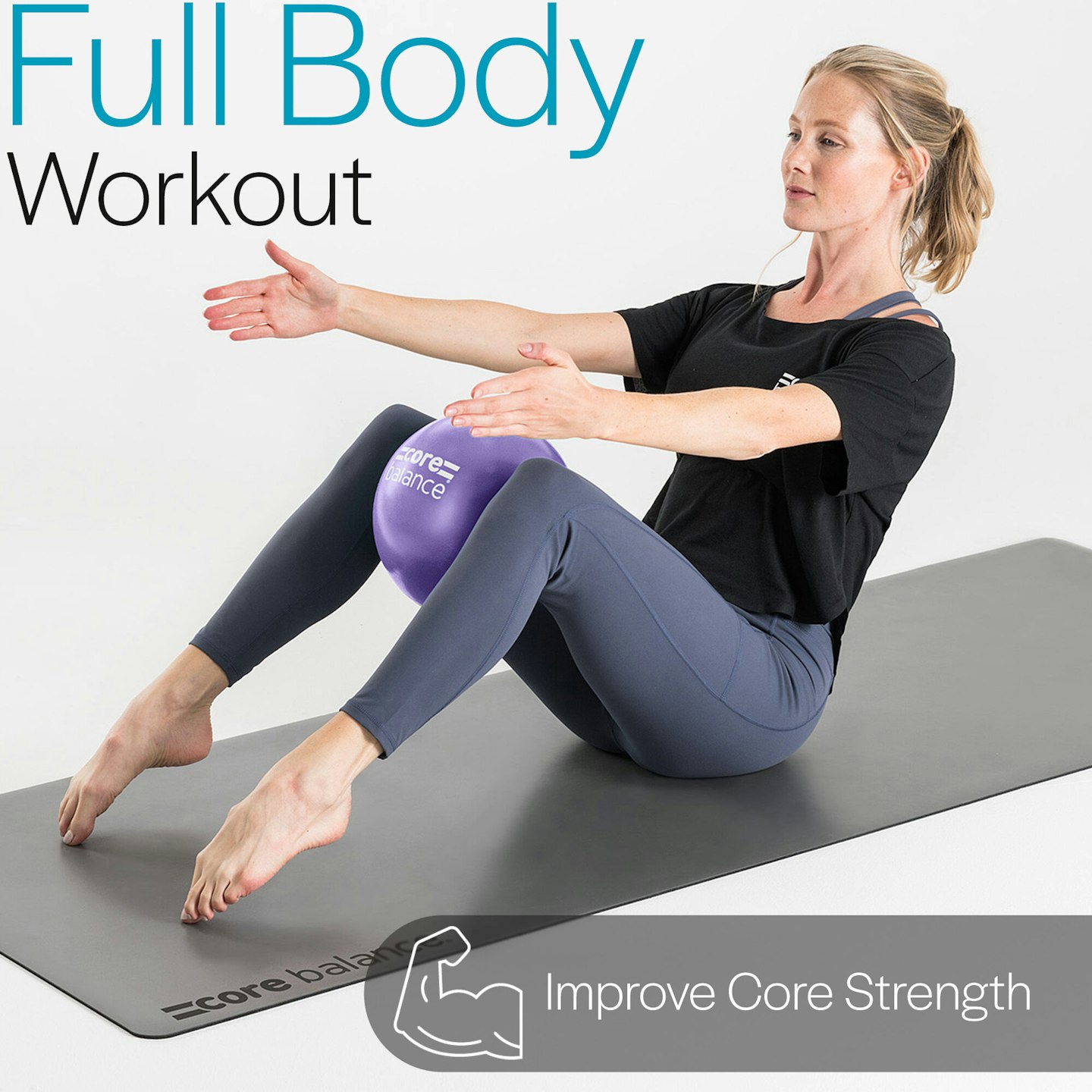 Core balance fitness
Core balance fitnesswww.corebalancefitness.co.uk
This durable ball is really effective if you're looking to build strength or flexibility. It includes a straw for easy inflation as well as a stopper plug removal tool so it's easy to deflate. This makes it perfect for a workout wherever you go.
Pros
- Made from durable PVC to prevent it bursting when punctured.
- The textured surface of the ball makes it non-slippery.
- Lightweight and portable.
Cons
- Some people felt the ball was smaller than expected when it arrived, so be sure you've familiarised yourself with the dimensions before ordering.
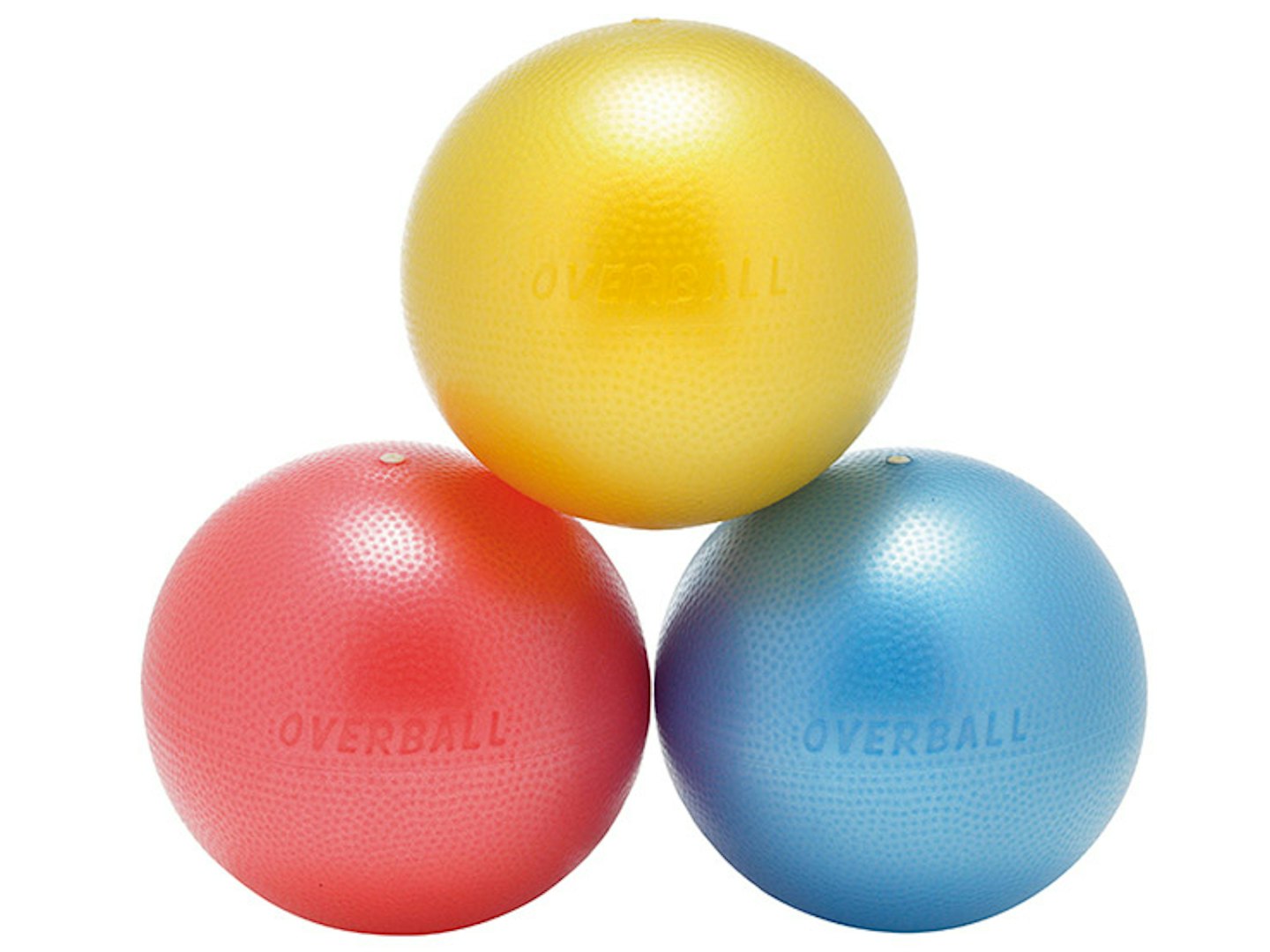 Physique
PhysiquePhysique over ball
This is multi-purpose ball from Physique is lightweight and soft, and can be used in so many Pilates exercises. This ball is great for muscle strengthening and low impact exercises and is an essential addition to any home gym, physiotherapy clinic, or fitness centre. Using this effectively can help prevent injury and ease muscle pain, so it is a great addition to your warm up routine.
Pros
- Comes with an inflation straw so inflation is not required.
- An affordable mix and match deal.
- Compact and lightweight so it fits easily into any gym bag.
Cons
- Some noticed that after a few weeks, the ball lost some of its original durability.
- The surface of the ball can be quite rough and abrasive.
Massage balls are the smallest and are about the size of a tennis ball. As the name suggests, these are used for massages or release work. These are used for targeting and releasing knotted muscles.
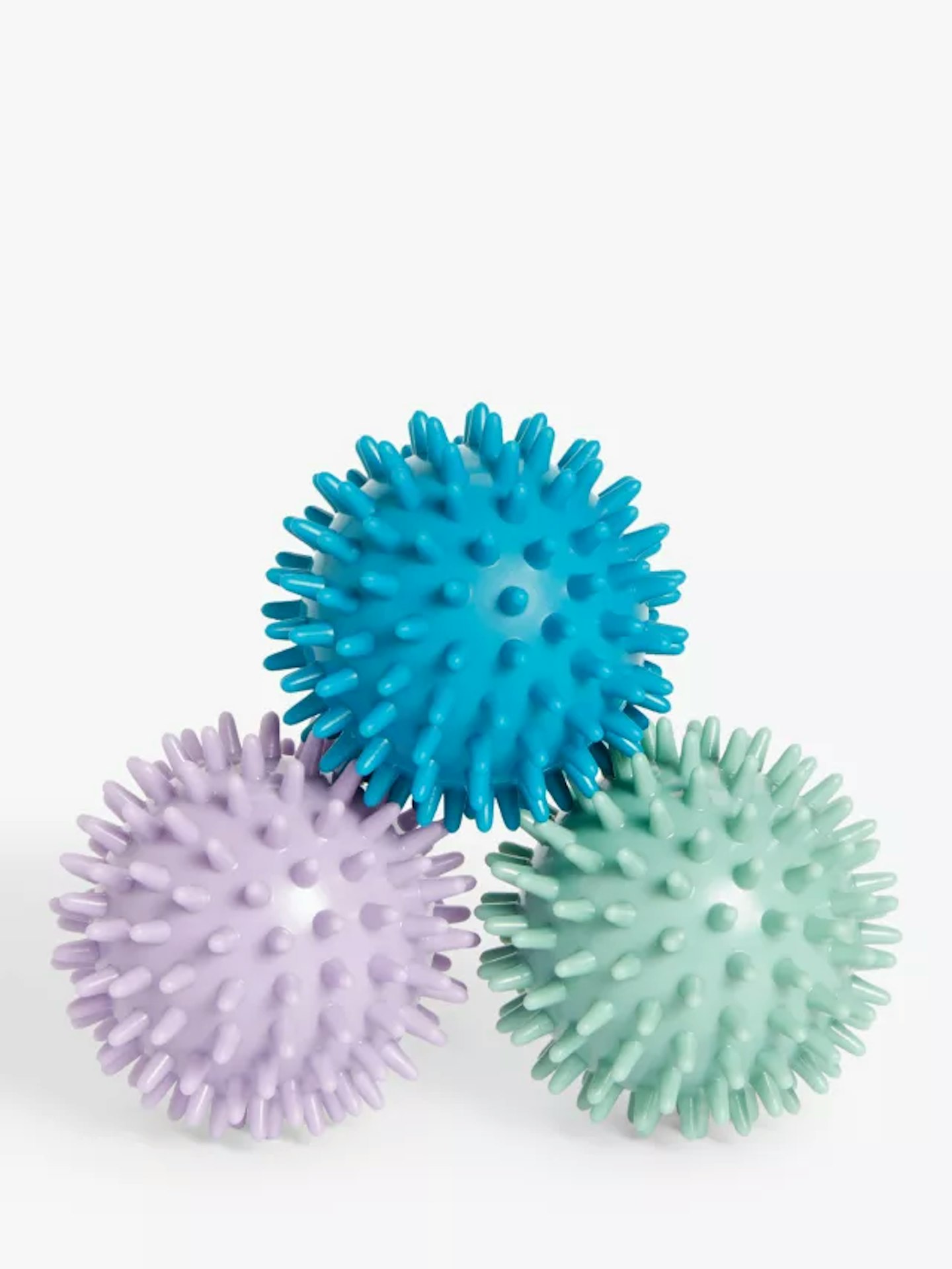 John Lewis
John Lewiswww.johnlewis.com
This set of three massage balls from John Lewis vary in firmness, meaning you'll have three different levels of intensity for your pain relief exercises. They're a great way to relieve tight muscles, improve circulation and release toxins.
Pros
- Easy to clean.
- Great for relieving back tension.
- Easily portable to and from the gym because of their size.
- Made from really durable material.
Cons
- While they're really effective for smaller muscle groups, they're less effective when it comes to large areas.
 Phyisical Company
Phyisical CompanyPhysical Company Prickle Balls
Each of these balls from Physical Company measures at 9-10cm and is made from PVC. Their prickle texture is perfect for working out tough knots and relieving pressure in the neck and back. Using these can help circulation and tension, plus they'll leave you feeling really relaxed.
Pros
- The perfect size for massaging out knots.
- Easily portable.
- Long-lasting due to their durable material.
Cons
- Some can find the prickly texture a little uncomfortable, so it may be best to work your way up to this.
What are the benefits of a Pilates ball?
There are many benefits to incorporating a Pilates ball in your workout routine.
Back and spine health
Certain exercises can damage your spine over time. Pilates balls provide back support which helps protect your spine in the long run. They can also help you achieve a deeper stretch without causing any harm. Pilates balls have even been adopted by physical therapists for injury recovery.
According to healthandcare.co.uk, "Exercise balls work by strengthening the core overall, stabilising the spine to reduce pain and discomfort, and providing excellent lumbar support. This in turn strengthens the back, helping to mobilise the body quickly and effectively."
Working your core
It is important to engage your core no matter what exercise you’re doing. By using a Pilates ball, you’re making the surface unstable, and forcing yourself to use your core muscles to stabilise.
Power Pilates UK founder Korin Nolan says that Pilates balls are “great for getting a deep abdominal connection as it forces you to find stability through your core. It’s not just good for your mid-section, though. A Pilates ball can also be used to strengthen your arms or legs with simple squeezes, or even just holding it in place.”
Challenging yourself
Pilates balls can add an extra resistance if you’re getting tired of your usual exercises. Using a Pilates ball can help target specific muscles and work them harder than traditional workouts.

What exercises can I do with a Pilates ball?
Figure eights
This exercise will engage your core and is a great beginner’s exercise if you’re first starting out with your Pilates ball.
1. Lie flat on your mat with one leg straight up to the sky and the other leg straight and hovering above the floor.
2. Lift yourself into a crunch position, take the Pilates ball in one hand and weave it between your lifted leg, passing the ball to the other hand and switching your leg lifts in a scissor motion. As you alternate leg lifts, weave the ball in a figure 8 shape around your legs.
3. Keep your shoulders lifted throughout the exercise and rotate your upper body as you bring the ball between your legs.
Deep core over ball
1. Lay on your back on your yoga mat.
2. Lift your hips and place the Pilates ball under your pelvis, keeping the back of your head and upper back connected to the mat.
3. From this position you can do several exercises. Try 90-degree heel taps or extending one leg straight at a time, you’ll find that the lower you go, the harder it gets.
Tabletop crunches
This exercise is a way to use an over ball in your workout. Think of these as elevated crunches that really target your core.
1. First, lie on your back with your knees bent.
2. Place the Pilates ball at the top of your knees, and place both hands on your head, using your elbows to secure the ball in place.
3. Once both legs and both elbows are holding the ball in place, pulse your upper body in and out with small crunches, ensuring your back is flat on the ground.
Bicycle crunches
You may already be doing these regularly, but incorporating a Pilates ball can add that extra core exercise.
1. Get into the same position as when you were doing tabletop crunches.
2. Keep your left elbow and right knee connected to the ball you rotate your upper body to the right and straighten your left leg at the same time.
3. Bring it back to centre and rotate the other way, keeping the ball between your right elbow and left knee while straightening your right leg.
4. Keep alternating.
Bridges
1. Lay face-up on the mat with your feet flat on the ground.
2. Place the ball under one foot.
3. Press firmly on your foot so that your pelvis lifts just a few inches, keeping your pelvis parallel to the floor.
4. You should feel this exercise in the centre and upper parts of the back of your leg.
5. Lower yourself with the same control and repeat.
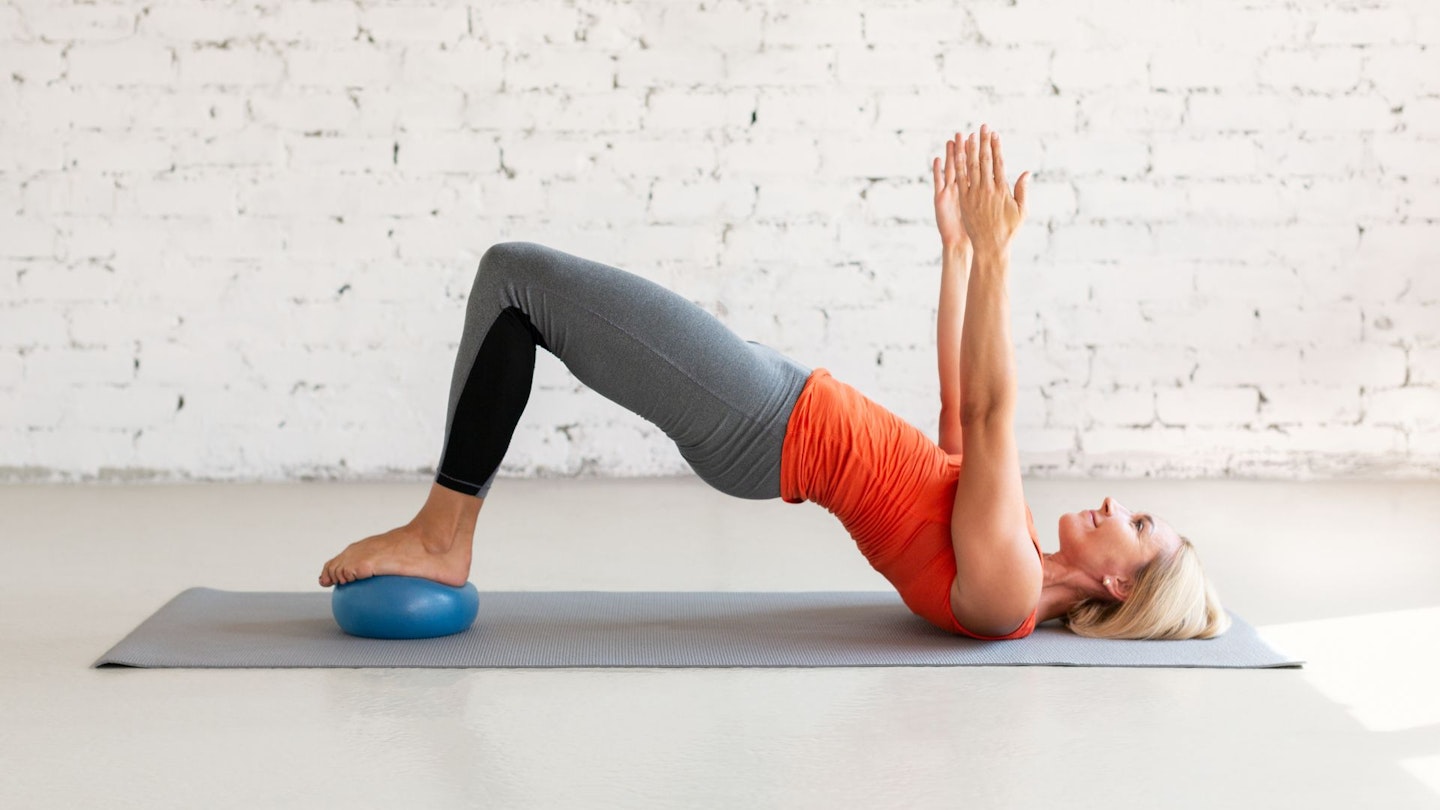
FAQs
What is the difference between a yoga ball and a Pilates ball?
The main difference between the two is size. A Pilates ball is also called an over ball, and as explained about, these are usually around the size of a football, whereas a yoga ball is also called a stability ball and is much larger. Due to the size difference, they are used in drastically different exercises.
Sarah O’Byrne has been an editorial assistant at heat, Closer and Yours since May 2023. She has a BA in English with Film and an MA in Literature and Culture - both from University College Dublin.
To enjoy more regular stories just like this, become a Yours subscriber and become part of our fun and friendly community of like-minded readers.
